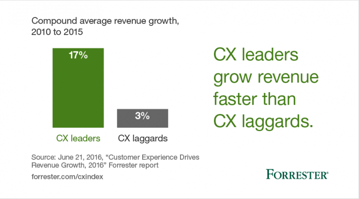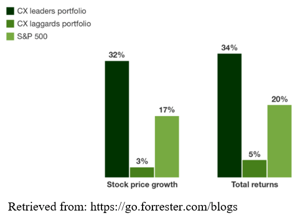en
Enthusiasm and satisfaction can profit a business, but customer engagement can more importantly increase sales to existing customers, improving overall business revenue. To obtain those benefits, CX transformation leaders need to invest in training, technology, and professional services.
A study of the Journal of the Academy of Marketing Science showed three elements: firstly, managers overestimate the extent to which customers are satisfied and loyal, which leads to further declines in customer satisfaction. Secondly, managers underestimate the extent to which customer satisfaction drives complaints and loyalty by almost 40%. Thirdly, when manager perceptions are misaligned with customer perceptions, customer satisfaction suffers. Customer Experience is often considered as derived from the marketing concept, however, it stresses more the individual customer intelligence and its nature of dialogical interaction.

Research has shown that when executives chase fads, customers and investors are bound to have lower satisfaction and/or financial performance. Consequently, losing from competitors becomes a firm fact. Enterprises need to jog their memory and see that their main objective is to satisfy customers and to be of value for investors as CX is said to predict sales, margins, cash flow, market share and stock returns. According to Bruce Temkin better CX really leads to more purchases.
A recent study by Rosetta, interviewing 4,800 US consumers on their customer experience with market-leading brands, has shown that these consumers buy services or products 90% more frequently and spend 60% more per purchase. Moreover, these customers even said they were five times more likely to only buy services from that particular brand in the future. Furthermore, highly engaged customers are willing to turn a blind eye to functional and occasional shortcomings. They stay committed, even when a negative experience occurs or when prices increase.
We all know about the phenomenon “Apple”. They distinguish themselves from other companies with their excellent Customer Experience and Customer Centricity. Apple mainly focuses on building relationships to sell more products. The company emphasises the value of its people and not its products. Their secret is to focus on Customer Emotions and to look at the psychological aspects of Customer Experience, both consciously (rational part: speed of delivery, how quickly a phone call is answered, etc.) and subconsciously. Both of these can evoke emotions. And we all know that a happy customer is a customer who will buy things. However, some companies are not aware of subconscious and emotional experiences. The lack of attention to these areas drives complaints and costs because of the poor experience. Additionally, it can negatively affect customer retention and customer loyalty.
These elements lead to engaged customers, who are of great value for a brand. More specifically, these consumers will deliver three times the value to the brand in only one year. They will spend more at present and in the future. To illustrate this we would like to mention a study by Bansal who discussed athletic clothing shoppers. Her results showed that highly engaged athletic clothing customers compared to non-engaged customers spend 97% more on average and purchase 94% more frequently. Furthermore, these trends are present in different markets, from financial services to fast food and so on.
Many companies measure customer satisfaction on the basis of the provided Customer Experience. Mid-size companies across industries are increasingly focused on Customer Experience to distinguish themselves from competitors and to build customer loyalty. In other words, Customer Experience is a revenue issue that can influence the financial health of the company. But how can we stimulate customer engagement?
 Although Customer Experience is a revenue issue, it is often difficult to demonstrate the direct link between CX and revenue growth or business success. Nonetheless, Forrester research has shown that customer experience leads to turnover increase. His research has confirmed that CX leaders crush CX laggards across several evaluated industries on both stock price growth and total returns.
Although Customer Experience is a revenue issue, it is often difficult to demonstrate the direct link between CX and revenue growth or business success. Nonetheless, Forrester research has shown that customer experience leads to turnover increase. His research has confirmed that CX leaders crush CX laggards across several evaluated industries on both stock price growth and total returns.
A portfolio of CX laggards from October 3th, 2016 to October 2nd, 2017 confirmed that statement and showed that the price of top brands in the CX Index grew 32%, compared to 3% for lagging brands. Moreover, the portfolio of CX leaders outperformed the S&P 500 Index, which returned 20%.
Superior Customer Experience drives substantial revenue growth for investments firms. But what is the Return On Investment? To determine ROI, a simple calculation can be made:
ROI = (Benefit – Cost) / Cost.
However there is one thing to bear in mind: higher-level CX drives superior significant growth in industries, but only when customers are free to switch business and when competitors distinguish their customer experience from others.
And why should you invest in a CX platform like Hello Customer?

Subscribe to the Hello Customer newsletter and receive the latest industry insights, interesting resources and other updates.